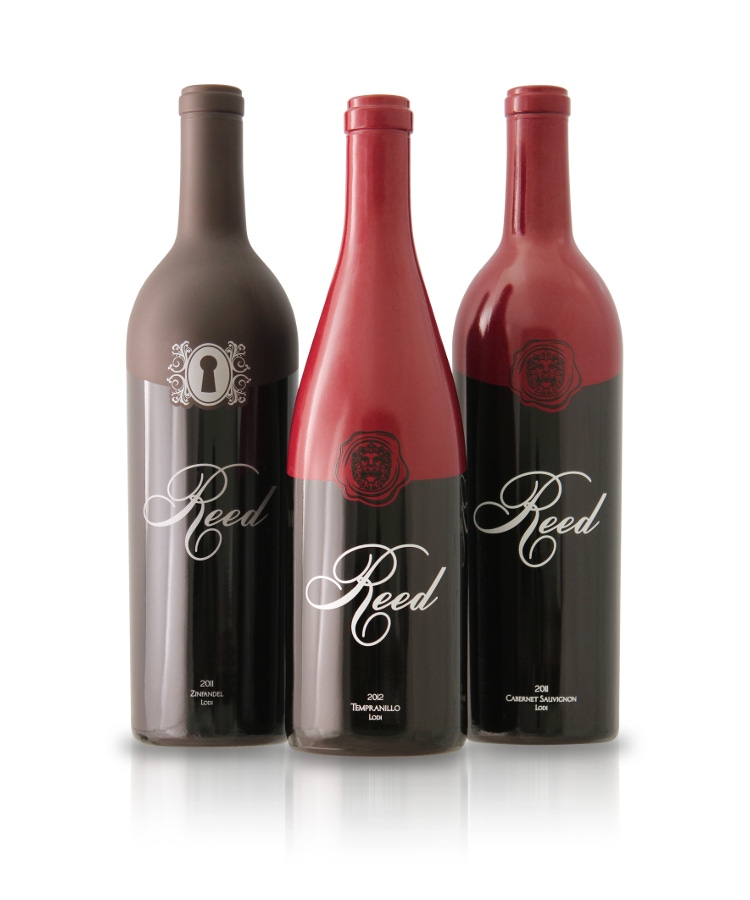Top-to-bottom decorating distinguishes wine bottles

Direct-to-glass decorating is making a comeback in some markets, such as wine. It plays a central role in Reed Wine Cellars’ new packaging design, which features bold graphics that start on the body of the bottle and extend all the way up the neck.
To execute the design, the winery uses a combination of applied ceramic labeling (ACL) and a technique called Mask Spray, from Quest Industries. The spray technique is used to decorate the top of the bottles; ACL is used for the brand name on the bottle’s front and also for the legal language and other text on the back.
Because the sprayed coating completely covers the top of the bottle, the package looks like it was dipped in wax. A detailed lion’s face appears on the front shoulder of the bottle, as if stamped in the “wax.” The spray technique offers a full-coverage solution not available with ACL and other decorating methods.
The Mask Spray process starts with masking bottles and spraying them either with ceramic coatings, as in Reed Wine Cellars’ case, or with organic coatings. The bottles are then heat cured, and the masks are removed. Up to four colors can be applied on a bottle, with high-quality rendering of fine details.
Neither the ceramic or organic coatings use heavy metals, so they are compliant with California’s Proposition 65, known officially as the Safe Drinking Water and Toxic Enforcement Act of 1986. The act requires a warning label on any product sold in California that contains chemicals, such as heavy metals used in many packaging inks, known to the state to cause cancer and birth defects or other reproductive harm. Yet the Mask Spray coatings still provide vibrant color without the use of heavy metals. Complying with Prop 65 is a pretty big deal, especially since California is home to so many wineries.
Reed Wine Cellars decorates the bottles for all its varietals—Cabernet Sauvignon, Zinfandel, Cabernet Franc, Tempranillo and Chardonnay—with a combination of spraying and ACL. Although each varietal bottle has a unique design, the spray technique brings continuity to the brand family.
The winery’s packaging represents the first commercialized application of Mask Spray; the technique has given “my brand a unique identity,” says Ryan Reed, who is the owner/winemaker at Reed Wine Cellars and also the chief technology officer at Quest. “I was looking for a simple, yet distinctive look that would be immediately identified as a Reed wine.”
Significantly, the spray decorating method “allows the entire bottle to become a creative canvas, unlocking design options which were simply not available before. The shelf appeal of the brand also increased dramatically, because I was able to decorate parts of the bottle no one else can,” explains Reed, who designed the graphics himself.
“When a consumer is facing the ‘wall of wine’ in a retail setting, the Reed Wine Cellars bottle stands out on the shelf because it breaks the line of sight of the numerous bottles decorated by traditional paper label or ACL,” he adds.
In addition to gaining a marketing advantage, Reed Wine Cellars was able to reduce packaging costs with the spray decorating: The graphics completely cover the neck of the bottle, so there’s no need for a capsule. “The savings of eliminating the capsule in my case was between 15 and 25 cents per bottle,” Reed says. “Since I produce fewer than a 1,000 cases, the capsule cost was high. Depending on the varietals, I was either using tin or polylaminate capsules.”
As a finishing touch for the package, the winery uses corks printed with the Reed logo.
The Mask Spray technique is automated and scalable, making it suitable for up to mass-market production volumes. “The whole process is integrated into a single-pass, automated production line,” Reed says. “This integrated line allows for maximum process control and efficiency that can handle anywhere from a few hundred cases to hundreds of thousands of cases and more.”
**********************************************************************
See a host of new ideas in package decorating and more at PackEx Montreal 2016, Nov. 30-Dec. 1, in Montreal, Quebec, Canada.
About the Author(s)
You May Also Like




